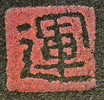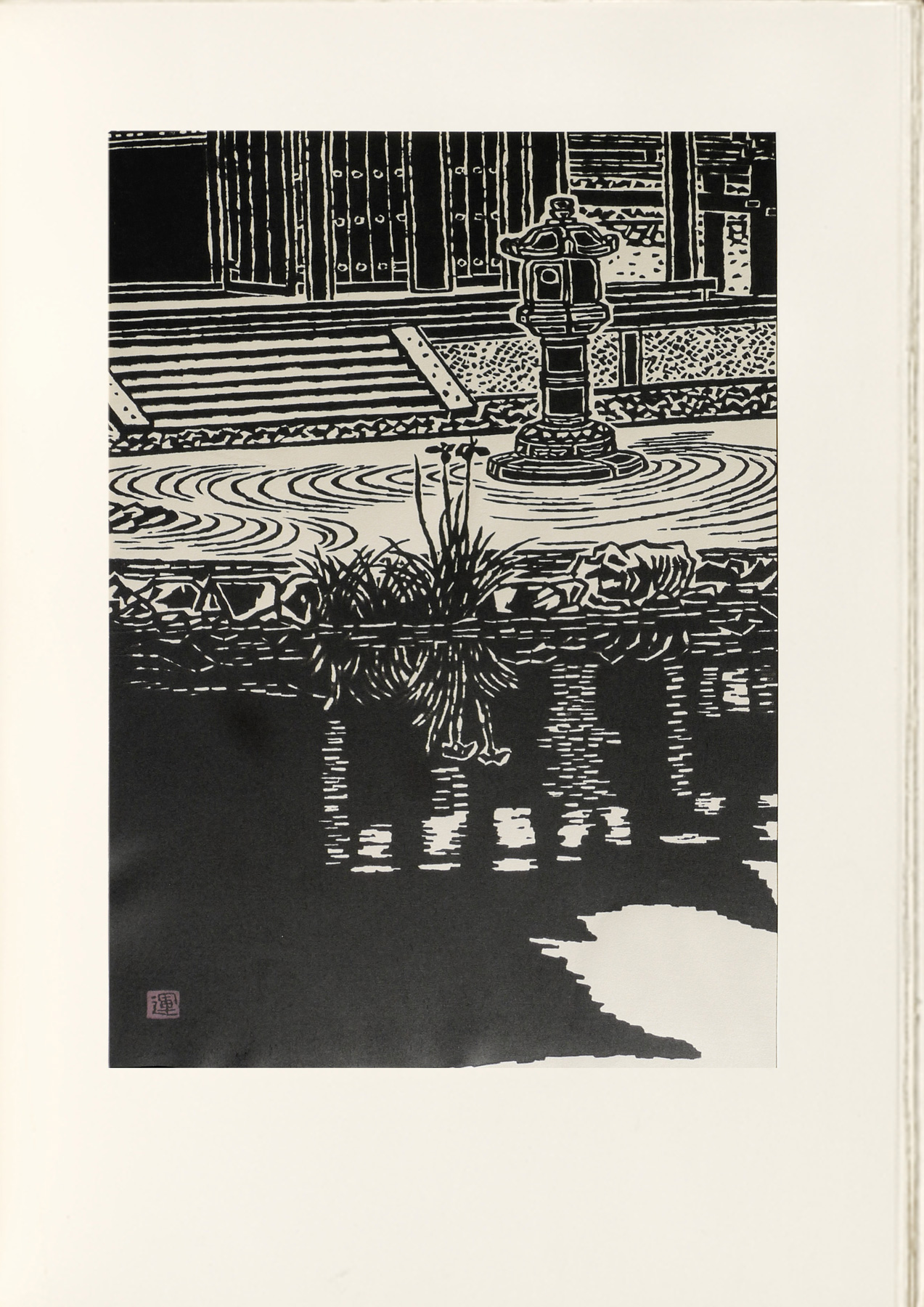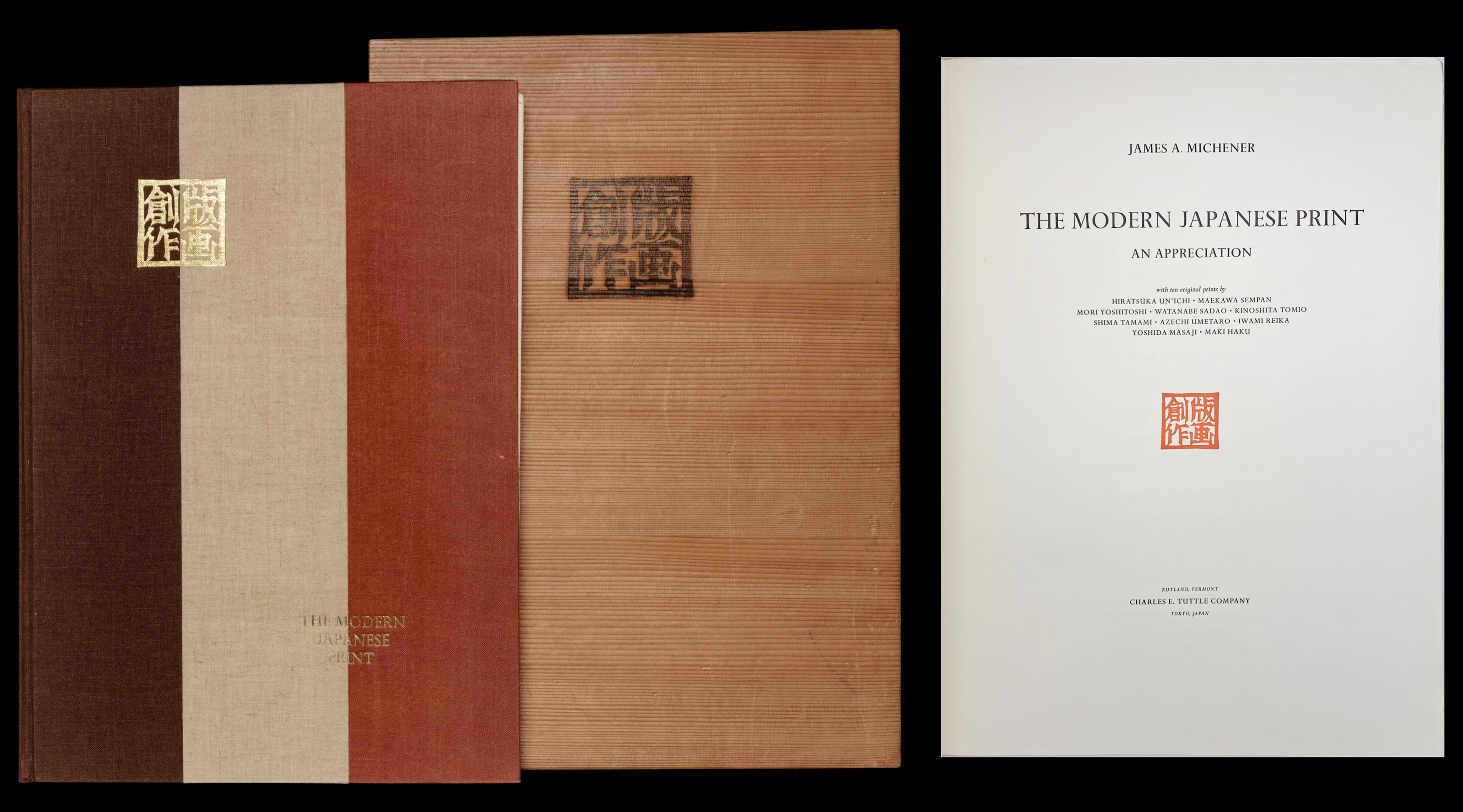About This Print
One of ten modern prints by ten different artists chosen for James Michener’s 1962 seminal work and portfolio of prints The Modern Japanese Print: An Appreciation, a work that brought Hiratsuka and the other artists to international attention.
"The Modern Japanese Print: An Appreciation" by James Michener
Note: Each print is tipped into Michener's book and placed under a mat that covers its margin, hiding the artist's signature, the print's title and the edition number on most of the prints.
IHL Cat. 1336
James A. Michener, The Modern Japanese Print: An Appreciation, 1962
Bound book with ten original prints by Hiratsuka Un'ichi, Maekawa Senpan,
Watanabe Sadao, Kinoshita Tomio, Shima Tamami, Azechi Umemtarō*,
Iwami Reika,Yoshida Masaji, Maki Haku and Mori Yoshitoshi,
housed in a wooden slipcase
(* This collection's book is missing the prints by Azechi Umemtarō and Yoshida Masaji.)
In his introduction to this print, Michener writes in part:
That one soft-spoken man dressed in a Russian-type smock should have been able to capture in one print the essence of things Japanese must remain a miracle. Yet here in this apparently simple work Hiratsuka Un'ichi has imprisoned much of the timeless beauty that characterizes Japan.
Artistically, the print is also an appropriate one with which to start a study of what is occurring in modern Japanese prints, for it is exclusively Japanese. Not a single alien component intrudes. The paper is a famous old make especially suited for prints. The ink is the same that has been for the last two-thousand years, made in the same way. The sever restriction to black and white follows the convention of the first great prints of Moronobu and his vigorous school of progenitors. Even the cutting of the wood is done with the same kinds of tools that the earliest artists used and with the same result in jagged line setting forth powerful solid areas. Technically, one can imagine this print to have been made three hundred years ago, and it is a joy to realize that what was so satisfying then remains so today.
But beyond the chance components of the print, and its technical austerity, one sees depicted here one of the secrets of Japanese art: repose and serenity achieved by the use of tension and complete control. No more appropriate print than this could have been found with which to launch this book.
Hiratsuka himself offers the below commentary:
The first idea that came to my mind in creating a print for this contest was to show a lakeside view of the Byodo-in. The impression I received when I first stood on the spot from which this print was conceived was so strong that it completely captured my heart. Hence I wanted to capture and present in the most powerful fashion that quiet moment in the afternoon when only the faint chirping of birds and the gentle rustle of falling autumn leaves could be heard. I have always believed that the motif of a print does not come through without inspiration, and that love and affection must accompany the carving and the printing. This work was created in that spirit.
The following technical information is also provided:
Artist's title: "Byodo-in Chihan" (Byodo-in Lakeside). Carved on a single board of honoki (Magnolia oborata T.) with a single flat chisel, seven millimeters wide, called an aisuki. Printed on hodomura paper from Fukui Prefecture, used raw without the usual dosa sizing in order to allow the sumi ink (Ryu'un from a Kyoto maker specializing in traditional ink) to sink into the paper to give depth to the print. Self-printed with many impressions of different parts (up to fifteen or sixteen for the lake area) to achieve the degree of blackness desired. The printing of each copy required about thirty minutes, with more than sixty unsatisfactory cast-offs.
1 The Modern Japanese Print - An Appreciation, James Michener, Charles E. Tuttle Co., 1968, p. 16-17.
2 Ibid., p. 18.
3 Ibid.
Print Details
latest revision:
| IHL Catalog | #1336a |
| Title | Byōdō-in Lakeside (Byōdō-in chihan 平等院池畔 |
| Artist | Hiratsuka Un'ichi (1895-1997) |
| Signature |  Un-ichi Hiratsuka in pencil right side of bottom margin  平塚運一 Hiratsuka Un-ichi bottom or right margin |
| Seal |  |
| Publication Date | 1962 |
| Edition | 463/510 |
| Publisher | Charles E. Tuttle Company, Tokyo |
| Carver | self-carved |
| Printer | self-printed |
| Impression | excellent |
| Colors | excellent |
| Condition | excellent |
| Genre | sosaku-hanga (creative print) |
| Miscellaneous | |
| Format | dai-ōban |
| H x W Paper | 16 1/4 x 12 3/16 in. (41.3 x 31 cm) |
| H x W Image | 15 1/8 x 11 in. (38.4 x 27.9 cm) |
| Collections This Print | Portland Art Museum, Portland, Oregon 2004.39a; Brooklyn Museum 63.15.1; Philadelphia Museum of Art 1964-201-1(10); Birmingham Museum of Art, Alabama 1990.93.1; The British Museum 1981,0205,0.1.1; Weatherspoon Art Museum, The University of North Carolina 1981.2837.1; Honolulu Museum of Art 14934 |
| Reference Literature | The Modern Japanese Print: An Appreciation, James A. Michener, [with Ten Original Prints by Hiratsuka Un'Ichi, Maekawa Sempan, Mori Yoshitoshi, Watanabe Sadao, Kinoshita Tomio, Shima Tamami, Azechi Umetaro, Iwami Reika, Yoshida Masaji, Maki Haku], Rutland, Charles E. Tuttle Company, 1962; The Modern Japanese Print - An Appreciation, James Michener, Charles E. Tuttle Co., 1968 [the "popular edition"] |
8/30/2021 created



